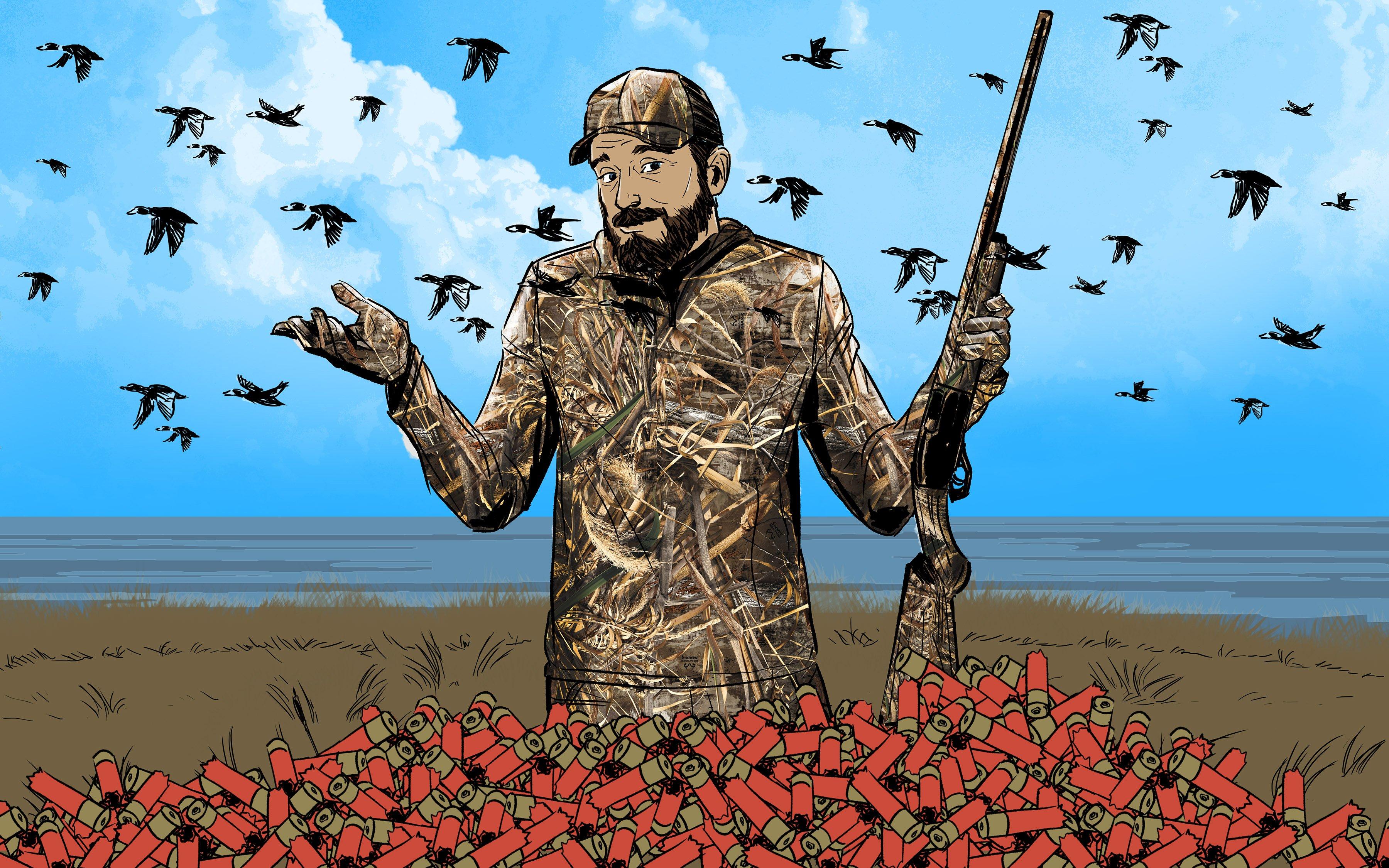Embarrassing misses are part of the waterfowling game. Just ask the author
My first duck never had a chance.
Buffeted by cold October winds, the hen mallard lifted off the open water of Pool 9 of the Mississippi River and fluttered down into our meager shoreline decoy spread. I reacted the way any 12-year-old newbie would — letting her splash down 5 steps away and then ground-swatting her with my single-shot 20-gauge.
My shooting percentage was perfect. And some might say that performance has swiftly regressed during 40 subsequent duck seasons. But before I reveal too many embarrassing details, let's admit that shooting ducks and geese can be tough. And many shots prove challenging, even for veteran hunters. No one expects to fold every bird they shoot at. Still, most serious hunters will hone their wingshooting over time to eventually achieve a respectable average.
But many days, human error gets in the way. Humorous, frustrating and even embarrassing misses ensue. And during almost four decades of obsessive waterfowl hunting, I've committed my share. Here are some memorable shooting gaffes from my log (plus a few mentions of good performances to convince you I'm not completely inept).
The Early Years
Young shooters often struggle because of inexperience, which is a shame, because your reflexes and eyesight are never better than when you're young. But until you've honed your shooting chops through endless repetition, you'll often miss.
My biggest humiliation occurred in high school, when my dad took me to a local wildlife area for the duck opener. We found a small pothole in the crowded marsh and were immediately inundated with bluewings that twisted and crossed everywhere at cattail level. Feeling optimistic (I'd killed three greenheads with three shots one day the previous November), I flailed away. Eleven teal passed through our hole that day, and 11 flew on. Finally, Dad halted the painful exhibition, and we paddled ashore. But I wasn't getting off easily.
The state wildlife agency was conducting a survey that morning, and a volunteer asked me how many shells I'd fired.
Eleven, I replied sheepishly.
And how many ducks did you get? he asked.
I considered lying but thought better of it. None."
None! the volunteer said, grinning. What happened?
In awkward teenager fashion, I didn't reply, and retreated to our old station wagon.
Years later, a college buddy and I had shot enough trap to think we were hot stuff. Maybe that's why we grinned with confidence as we crept up on a flock of coots on a lake one October afternoon. The birds flushed as we rose, and we hammered six shots at them. Seconds later, all the mudhens landed safely in a nearby bay as we stammered to make excuses.
Worse, we hadn't known other hunters were watching. After our whiff, taunting laughter erupted from their blind. We trudged back to our spot and picked up decoys without saying a word.
Later that season, another college pal gained access to duck nirvana: flooded marsh, pastures and cornfields off a river that connected to a huge federal refuge. We rowed his rickety old boat into the spot one afternoon and loaded up.
And we couldn't hit anything. Mallards, wigeon and teal graced our spread, and we sent most flying with three-shot volleys into nothing. Spent hulls littered the boat floor, and we dug into our second and then third boxes of shells. As closing time neared, we finally killed a suzie, a greenwing and a honker. Then, some wigeon cupped their wings and approached, floating almost motionless, offering a perfect finish to the hunt. We rose and fired six shots, missing every one.
Dang, my buddy said. There goes our average.
Peak Expectations
After college, I polished my wing-shooting skills to the point where I expected birds to fold instead of continuing to fly. I joined countless trap and skeet leagues, went on regular sporting clays outings and spent hundreds of days shooting ducks. Further, improvements in steel-shotshell technology increased lethality and boosted my confidence. Still, I was reminded often that perfection is rarely attainable.
Near the end of what was then my best season, I sat with a buddy and our mentor in a shoreline blind, watching the lake freeze. Suddenly, four mallards parachuted down from above and landed behind a small rock point 50 yards to our south. Our mentor tapped me on the shoulder and motioned for me to follow him.
Slipping quietly through short grass, we crept to within 10 steps of the startled ducks and flushed them perfectly. My friend calmly collected two fat drakes with his old double-barrel. Meanwhile, I pounded two shots over another greenhead before mercifully sneaking one pellet from the third round into its boiler room. The bird sailed 100 yards before splashing down and dying. And when my older friend turned toward me with an expressionless face, I knew what was coming.
Was that too hard of a shot for you? he asked.
And then there was the infamous drake bufflehead, which I've written about before. Two buddies and I had just killed nine buffies from a flock of 20 that decoyed perfectly. As the smoke cleared, an unscathed drake from the back of the group zipped across our decoys at 15 yards. Almost laughing and flush with pride from our triple trifecta, I chambered a shell, swung my gun leisurely ahead of the duck — and whiffed. Another buddy killed it, but chuckling soon broke out.
I can't believe that one gave us such a good chance, I said, face red under my stocking cap.
I can't believe you missed it, a friend said.
Even some of my best moments were questionable. One hazy October afternoon, a buddy and I huddled in his canoe when two ringnecks zipped toward us, banked left and then hit the afterburners. I rose to shoot the speeding drake but was immediately blinded by a wall of cattails. Without seeing the bird, I swung my barrel to where I thought the duck might be and slapped the trigger.
Splash. Nice shot, my friend exclaimed as his Lab swam to retrieve the dead ringer.
I never confessed that my picture-perfect crossing shot was literally blind luck.
Years later, fortune again boosted my performance on ringnecks. My dad and I had just set up at a South Dakota slough when three blackjacks rocketed over and then flared skyward. I swung my barrel aggressively in front of the lead bird and fired … killing the two behind it.
Great shot, Dad said, assuming those were the birds you were shooting at.
Oh yeah, I replied. He knew I was full of it.
Keep Shooting
Nowadays, I don't get too high or low with the inevitable ups and downs of shooting wild ducks. I expect to kill every bird that offers a decent shot, but I won't. Mistakes inevitably creep in. For every beautifully timed triple, there's a wild shot at a high crosser. I've simply learned to brush off the gaffes and make the most of the next opportunity. And along the way, I've recognized the challenge of shooting waterfowl is part of what makes duck hunting so enjoyable. Nothing is promised, and gimmes don't exist. Work hard to sharpen your skills, or ducks will expose you as a fool.
I was reminded of that this past November, when two mallards pitched into a semi-frozen pothole, offering the easiest shot you can imagine. Forty-one years of experience and muscle memory kicked in, and I rose, swung the gun smoothly and downed both birds with the first shell. But the left-hand bird required a finishing shot.
Great. There went my average.
Click here for more Realtree waterfowl hunting content. And check us out on Facebook.








